 Working in the kitchen, have you ever wondered whether you could grow peppers from pepper seeds? How about a mango tree from a mango pit? This book for gardeners of all ages explains how to germinate a wide range of commonly-seen seeds most people would usually toss in the bin. The entries detail what each plant would need to grow on to maturity, while an illustrated section at the end highlights basic gardening techniques as well as common problems and solutions.
Working in the kitchen, have you ever wondered whether you could grow peppers from pepper seeds? How about a mango tree from a mango pit? This book for gardeners of all ages explains how to germinate a wide range of commonly-seen seeds most people would usually toss in the bin. The entries detail what each plant would need to grow on to maturity, while an illustrated section at the end highlights basic gardening techniques as well as common problems and solutions.
Published in the August 2015 Leaflet Volume 2, Issue 8.
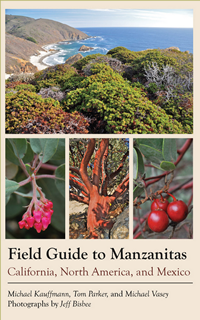 “Field Guide to Manzanitas” is a nearly comprehensive review of the genus Arctostaphylos, covering 104 of the 105 taxa in the world. Why is one missing? The excellent introduction to this book will answer that question and explore the origins and diversification that has led to one species (Arctostaphylos uva-ursi) being found throughout the northern hemisphere, while 60% of the remaining taxa are considered local endemics within the California Floristic Province. This book is a must for botanizing in California and helpful in making horticultural selections in the Pacific Northwest.
“Field Guide to Manzanitas” is a nearly comprehensive review of the genus Arctostaphylos, covering 104 of the 105 taxa in the world. Why is one missing? The excellent introduction to this book will answer that question and explore the origins and diversification that has led to one species (Arctostaphylos uva-ursi) being found throughout the northern hemisphere, while 60% of the remaining taxa are considered local endemics within the California Floristic Province. This book is a must for botanizing in California and helpful in making horticultural selections in the Pacific Northwest.
Published in the August 2015 Leaflet for Scholars Volume 2, Issue 8.
 “Field Guide to Grasses of California” is an excellent survey of the most common of the 603 taxa, both native and naturalized, in the state. James P. Smith is a professor emeritus of Humboldt State University and his teaching skills are evident throughout. While many species are not found in Washington (only 337 taxa), there is overlap especially with northern California. If you study grasses, this book is well worth reading for its methodology and for a confession (p. 123): “I do not want to discourage you, but you will not be able to identify every grass that you run through the key in this book…” The absolution that follows will lighten the heart of any student botanist.
“Field Guide to Grasses of California” is an excellent survey of the most common of the 603 taxa, both native and naturalized, in the state. James P. Smith is a professor emeritus of Humboldt State University and his teaching skills are evident throughout. While many species are not found in Washington (only 337 taxa), there is overlap especially with northern California. If you study grasses, this book is well worth reading for its methodology and for a confession (p. 123): “I do not want to discourage you, but you will not be able to identify every grass that you run through the key in this book…” The absolution that follows will lighten the heart of any student botanist.
Published in the July 2015 Leaflet for Scholars Volume 2, Issue 7.
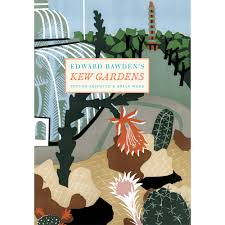 This book defies easy categorization. Bawden was a renowned British illustrator, graphic artist, and painter who served as an official War Artist during World War II. He and his contemporary Eric Ravilious studied with surrealist landscape painter and engraver Paul Nash, and his influence can be felt in Bawden’s lively calligraphic line, and his modernist approach to landscapes and cityscapes. Until exploring this book, I was most familiar with his posters for London Transport, depicting sights and scenes around London.
This book defies easy categorization. Bawden was a renowned British illustrator, graphic artist, and painter who served as an official War Artist during World War II. He and his contemporary Eric Ravilious studied with surrealist landscape painter and engraver Paul Nash, and his influence can be felt in Bawden’s lively calligraphic line, and his modernist approach to landscapes and cityscapes. Until exploring this book, I was most familiar with his posters for London Transport, depicting sights and scenes around London.
The first section of the book reproduces Bawden’s very early manuscript (created when he was just twenty), A General Guide to the Royal Botanic Gardens Kew, Spring and Easter 1923. The second section is a brief but eccentric sociocultural history of Kew, incorporating Kew-inspired illustrations, verse, and humor. The third section is a selection of Bawden’s wry illustrations for Robert Herring’s Adam and Evelyn at Kew. The last section summarizes his lifelong artistic fascination with Kew. Those who are interested in 20th century art and the history of Kew will find it a fascinating book to read and savor.
Reviewed by Rebecca Alexander
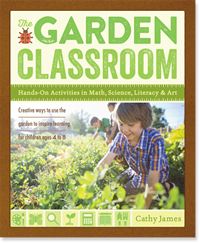 “Anything you can teach in an indoor classroom can be taught outdoors, often in ways that are more enjoyable for children.” This bold assertion opens Cathy James’ new book, and she proves her point with simple steps anyone who teaches children can take to enhance the curriculum outdoors. The projects are flexible, affordable and practical for small or large groups, aged 4 to 8. An invaluable resource for early education!
“Anything you can teach in an indoor classroom can be taught outdoors, often in ways that are more enjoyable for children.” This bold assertion opens Cathy James’ new book, and she proves her point with simple steps anyone who teaches children can take to enhance the curriculum outdoors. The projects are flexible, affordable and practical for small or large groups, aged 4 to 8. An invaluable resource for early education!
Published in the June 2015 Leaflet Volume 2, Issue 6.
 Can you grow “Epic Tomatoes” in the Pacific Northwest? A challenge, perhaps, but this new book by Craig LeHoullier will inspire you to try. Yes, he’s from Raleigh, North Carolina, but he lived in Seattle early in his gardening career. He’s most interested in heirlooms, suggests a rainbow of color options to try (a brown tomato anyone?), encourages you to grow from seed, and enlists the help of regional gardeners in finding the best varieties for our cool summers.
Can you grow “Epic Tomatoes” in the Pacific Northwest? A challenge, perhaps, but this new book by Craig LeHoullier will inspire you to try. Yes, he’s from Raleigh, North Carolina, but he lived in Seattle early in his gardening career. He’s most interested in heirlooms, suggests a rainbow of color options to try (a brown tomato anyone?), encourages you to grow from seed, and enlists the help of regional gardeners in finding the best varieties for our cool summers.
Published in the June 2015 Leaflet Volume 2, Issue 6.
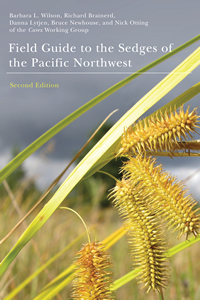 “Field Guide to Sedges of the Pacific Northwest” is regarded by reviewers across the country as one of the best field guides on any topic, and is even better in the newly released 2nd edition. Included are entries for all 169 species, subspecies, and varieties that grow wild in Oregon and Washington, with typically 4-6 photographs or diagrams of each. An extensive key helps with identification, as do detailed tips with each entry, while comments discuss habitat, ethnobotanical uses, and the significance for restoration.
“Field Guide to Sedges of the Pacific Northwest” is regarded by reviewers across the country as one of the best field guides on any topic, and is even better in the newly released 2nd edition. Included are entries for all 169 species, subspecies, and varieties that grow wild in Oregon and Washington, with typically 4-6 photographs or diagrams of each. An extensive key helps with identification, as do detailed tips with each entry, while comments discuss habitat, ethnobotanical uses, and the significance for restoration.
Published in the June 2015 Leaflet for Scholars Volume 2, Issue 6.
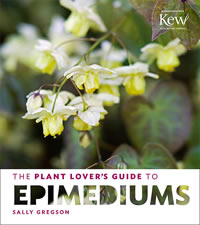 Kew Gardens has begun a very helpful series of books for gardeners known as The Plant Lover’s Guides. One of the best, partly because of the scarcity of other books on this topic, is The Plant Lover’s Guide to Epimediums by Sally Gregson. The availability of both species and hybrid epimediums has exploded in recent years, and this guide will introduce you to the new Chinese epimediums – “these are the divas” – as well as all the old favorites for dry shade. I’m especially impressed with the photographs as I know from experience the delicate flowers of this genus are very difficult to capture.
Kew Gardens has begun a very helpful series of books for gardeners known as The Plant Lover’s Guides. One of the best, partly because of the scarcity of other books on this topic, is The Plant Lover’s Guide to Epimediums by Sally Gregson. The availability of both species and hybrid epimediums has exploded in recent years, and this guide will introduce you to the new Chinese epimediums – “these are the divas” – as well as all the old favorites for dry shade. I’m especially impressed with the photographs as I know from experience the delicate flowers of this genus are very difficult to capture.
Published in the May 2015 Leaflet Volume 2, Issue 5.
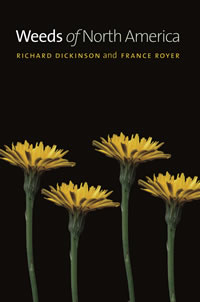 “Weeds of North America” is an excellent new guide to more than 600 invasive plants throughout the United States and Canada. Designed in field guide style, the photographs are a particularly strong feature of this book, with 3-5 for each plant, including leaves, flowers, and seeds. The text includes a description of the life cycle, jurisdictions that have identified the plant as noxious, and details on the reasons for concern, including displacement of native plant habitat, toxicity to livestock, and/or status as an alternative host of a serious plant disease.
“Weeds of North America” is an excellent new guide to more than 600 invasive plants throughout the United States and Canada. Designed in field guide style, the photographs are a particularly strong feature of this book, with 3-5 for each plant, including leaves, flowers, and seeds. The text includes a description of the life cycle, jurisdictions that have identified the plant as noxious, and details on the reasons for concern, including displacement of native plant habitat, toxicity to livestock, and/or status as an alternative host of a serious plant disease.
Published in the May 2015 Leaflet for Scholars Volume 2, Issue 5.
 As a first time vegetable gardener, I was looking for a resource for planting and growing vegetables from a small space: my deck. This handy book, Patio Produce: How to Cultivate a Lot of Home-Grown Vegetables from the Smallest Possible Space by Paul Peacock really helped me start my garden. It simply showed me how to make the most out of my pots and how to plan for a reasonable crop yield. I especially enjoyed the chapters on how to grow vegetables on the patio. The author has an A-Z plant list and inside there are detailed step-by-step instructions on how to grow on the patio, including an “at a glance” table that contains helpful information on the plant’s pot size, sowing dates, care, and harvest information. The short but thorough snippets on specific plants, such as raspberries, strawberries, potatoes, and tomatoes helped me understand how to plant and take care of my crops.
As a first time vegetable gardener, I was looking for a resource for planting and growing vegetables from a small space: my deck. This handy book, Patio Produce: How to Cultivate a Lot of Home-Grown Vegetables from the Smallest Possible Space by Paul Peacock really helped me start my garden. It simply showed me how to make the most out of my pots and how to plan for a reasonable crop yield. I especially enjoyed the chapters on how to grow vegetables on the patio. The author has an A-Z plant list and inside there are detailed step-by-step instructions on how to grow on the patio, including an “at a glance” table that contains helpful information on the plant’s pot size, sowing dates, care, and harvest information. The short but thorough snippets on specific plants, such as raspberries, strawberries, potatoes, and tomatoes helped me understand how to plant and take care of my crops.
 Working in the kitchen, have you ever wondered whether you could grow peppers from pepper seeds? How about a mango tree from a mango pit? This book for gardeners of all ages explains how to germinate a wide range of commonly-seen seeds most people would usually toss in the bin. The entries detail what each plant would need to grow on to maturity, while an illustrated section at the end highlights basic gardening techniques as well as common problems and solutions.
Working in the kitchen, have you ever wondered whether you could grow peppers from pepper seeds? How about a mango tree from a mango pit? This book for gardeners of all ages explains how to germinate a wide range of commonly-seen seeds most people would usually toss in the bin. The entries detail what each plant would need to grow on to maturity, while an illustrated section at the end highlights basic gardening techniques as well as common problems and solutions. “Field Guide to Manzanitas” is a nearly comprehensive review of the genus Arctostaphylos, covering 104 of the 105 taxa in the world. Why is one missing? The excellent introduction to this book will answer that question and explore the origins and diversification that has led to one species (Arctostaphylos uva-ursi) being found throughout the northern hemisphere, while 60% of the remaining taxa are considered local endemics within the California Floristic Province. This book is a must for botanizing in California and helpful in making horticultural selections in the Pacific Northwest.
“Field Guide to Manzanitas” is a nearly comprehensive review of the genus Arctostaphylos, covering 104 of the 105 taxa in the world. Why is one missing? The excellent introduction to this book will answer that question and explore the origins and diversification that has led to one species (Arctostaphylos uva-ursi) being found throughout the northern hemisphere, while 60% of the remaining taxa are considered local endemics within the California Floristic Province. This book is a must for botanizing in California and helpful in making horticultural selections in the Pacific Northwest. “Field Guide to Grasses of California” is an excellent survey of the most common of the 603 taxa, both native and naturalized, in the state. James P. Smith is a professor emeritus of Humboldt State University and his teaching skills are evident throughout. While many species are not found in Washington (only 337 taxa), there is overlap especially with northern California. If you study grasses, this book is well worth reading for its methodology and for a confession (p. 123): “I do not want to discourage you, but you will not be able to identify every grass that you run through the key in this book…” The absolution that follows will lighten the heart of any student botanist.
“Field Guide to Grasses of California” is an excellent survey of the most common of the 603 taxa, both native and naturalized, in the state. James P. Smith is a professor emeritus of Humboldt State University and his teaching skills are evident throughout. While many species are not found in Washington (only 337 taxa), there is overlap especially with northern California. If you study grasses, this book is well worth reading for its methodology and for a confession (p. 123): “I do not want to discourage you, but you will not be able to identify every grass that you run through the key in this book…” The absolution that follows will lighten the heart of any student botanist. This book defies easy categorization. Bawden was a renowned British illustrator, graphic artist, and painter who served as an official War Artist during World War II. He and his contemporary Eric Ravilious studied with surrealist landscape painter and engraver Paul Nash, and his influence can be felt in Bawden’s lively calligraphic line, and his modernist approach to landscapes and cityscapes. Until exploring this book, I was most familiar with his posters for London Transport, depicting sights and scenes around London.
This book defies easy categorization. Bawden was a renowned British illustrator, graphic artist, and painter who served as an official War Artist during World War II. He and his contemporary Eric Ravilious studied with surrealist landscape painter and engraver Paul Nash, and his influence can be felt in Bawden’s lively calligraphic line, and his modernist approach to landscapes and cityscapes. Until exploring this book, I was most familiar with his posters for London Transport, depicting sights and scenes around London. “Anything you can teach in an indoor classroom can be taught outdoors, often in ways that are more enjoyable for children.” This bold assertion opens Cathy James’ new book, and she proves her point with simple steps anyone who teaches children can take to enhance the curriculum outdoors. The projects are flexible, affordable and practical for small or large groups, aged 4 to 8. An invaluable resource for early education!
“Anything you can teach in an indoor classroom can be taught outdoors, often in ways that are more enjoyable for children.” This bold assertion opens Cathy James’ new book, and she proves her point with simple steps anyone who teaches children can take to enhance the curriculum outdoors. The projects are flexible, affordable and practical for small or large groups, aged 4 to 8. An invaluable resource for early education! Can you grow “Epic Tomatoes” in the Pacific Northwest? A challenge, perhaps, but this new book by Craig LeHoullier will inspire you to try. Yes, he’s from Raleigh, North Carolina, but he lived in Seattle early in his gardening career. He’s most interested in heirlooms, suggests a rainbow of color options to try (a brown tomato anyone?), encourages you to grow from seed, and enlists the help of regional gardeners in finding the best varieties for our cool summers.
Can you grow “Epic Tomatoes” in the Pacific Northwest? A challenge, perhaps, but this new book by Craig LeHoullier will inspire you to try. Yes, he’s from Raleigh, North Carolina, but he lived in Seattle early in his gardening career. He’s most interested in heirlooms, suggests a rainbow of color options to try (a brown tomato anyone?), encourages you to grow from seed, and enlists the help of regional gardeners in finding the best varieties for our cool summers. “Field Guide to Sedges of the Pacific Northwest” is regarded by reviewers across the country as one of the best field guides on any topic, and is even better in the newly released 2nd edition. Included are entries for all 169 species, subspecies, and varieties that grow wild in Oregon and Washington, with typically 4-6 photographs or diagrams of each. An extensive key helps with identification, as do detailed tips with each entry, while comments discuss habitat, ethnobotanical uses, and the significance for restoration.
“Field Guide to Sedges of the Pacific Northwest” is regarded by reviewers across the country as one of the best field guides on any topic, and is even better in the newly released 2nd edition. Included are entries for all 169 species, subspecies, and varieties that grow wild in Oregon and Washington, with typically 4-6 photographs or diagrams of each. An extensive key helps with identification, as do detailed tips with each entry, while comments discuss habitat, ethnobotanical uses, and the significance for restoration. Kew Gardens has begun a very helpful series of books for gardeners known as The Plant Lover’s Guides. One of the best, partly because of the scarcity of other books on this topic, is The Plant Lover’s Guide to Epimediums by Sally Gregson. The availability of both species and hybrid epimediums has exploded in recent years, and this guide will introduce you to the new Chinese epimediums – “these are the divas” – as well as all the old favorites for dry shade. I’m especially impressed with the photographs as I know from experience the delicate flowers of this genus are very difficult to capture.
Kew Gardens has begun a very helpful series of books for gardeners known as The Plant Lover’s Guides. One of the best, partly because of the scarcity of other books on this topic, is The Plant Lover’s Guide to Epimediums by Sally Gregson. The availability of both species and hybrid epimediums has exploded in recent years, and this guide will introduce you to the new Chinese epimediums – “these are the divas” – as well as all the old favorites for dry shade. I’m especially impressed with the photographs as I know from experience the delicate flowers of this genus are very difficult to capture. “Weeds of North America” is an excellent new guide to more than 600 invasive plants throughout the United States and Canada. Designed in field guide style, the photographs are a particularly strong feature of this book, with 3-5 for each plant, including leaves, flowers, and seeds. The text includes a description of the life cycle, jurisdictions that have identified the plant as noxious, and details on the reasons for concern, including displacement of native plant habitat, toxicity to livestock, and/or status as an alternative host of a serious plant disease.
“Weeds of North America” is an excellent new guide to more than 600 invasive plants throughout the United States and Canada. Designed in field guide style, the photographs are a particularly strong feature of this book, with 3-5 for each plant, including leaves, flowers, and seeds. The text includes a description of the life cycle, jurisdictions that have identified the plant as noxious, and details on the reasons for concern, including displacement of native plant habitat, toxicity to livestock, and/or status as an alternative host of a serious plant disease. As a first time vegetable gardener, I was looking for a resource for planting and growing vegetables from a small space: my deck. This handy book,
As a first time vegetable gardener, I was looking for a resource for planting and growing vegetables from a small space: my deck. This handy book,